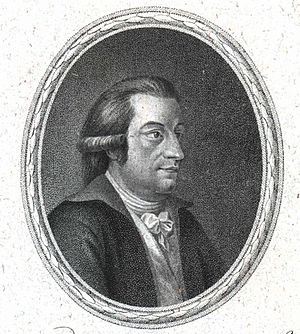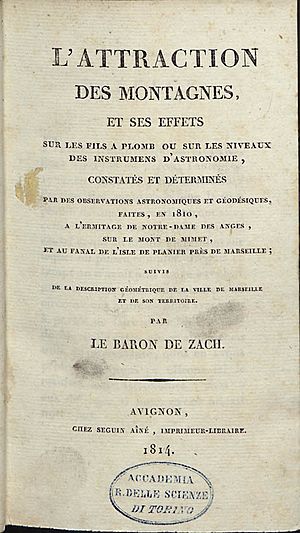Franz Xaver von Zach facts for kids
Quick facts for kids
Franz Xaver von Zach
|
|
|---|---|
 |
|
| Born | 4 June 1754 Pest
|
| Died | 2 September 1832 (aged 78) Paris
|
| Nationality | Hungarian |
| Scientific career | |
| Fields | astronomy |
Baron Franz Xaver von Zach (born June 4, 1754 – died September 2, 1832) was a Hungarian astronomer. He was born in Pest, Hungary, which is now part of Budapest. He became well-known for his work studying the stars and planets.
Contents
Life and Discoveries
Franz Xaver von Zach first studied physics at the Royal University of Pest. After that, he served for a while in the Austrian army. He later taught at the University of Lemberg, which is now in Ukraine. He also worked at its observatory.
Working with Famous Astronomers
From 1780 to 1783, Zach lived in Paris. Then, from 1783 to 1786, he lived in London. In London, he worked as a tutor for the Saxon ambassador's family. During these years, he met many famous astronomers. These included Joseph de Lalande, Pierre-Simon Laplace, and William Herschel.
Leading the Gotha Observatory
In 1786, Duke Ernest II of Saxe-Gotha-Altenburg hired Zach. He became the director of a new observatory. This observatory was built on Seeberg hill in Gotha, Germany. It was finished in 1791.
The "Celestial Police"
Near the end of the 1700s, Zach organized a special group. He called them the "celestial police." This group had twenty-four astronomers. Their goal was to search for a "missing planet." People thought this planet should be between Mars and Jupiter. This idea came from a rule called the Titius-Bode law.
Just as their search began, a dwarf planet named Ceres was found by accident. Ceres was later lost from sight when it passed behind the Sun. Using predictions from Carl Friedrich Gauss, Zach found Ceres again. This happened on December 31, 1801, or January 1, 1802. Another astronomer, Heinrich Wilhelm Matthias Olbers, also found it one night later.
Later Years and Observations
After the duke died in 1804, Zach traveled with the duke's widow. They settled in Genoa, Italy, in 1815. There, he managed another observatory. In 1827, he moved back to Paris. He passed away there in 1832.
Zach published a book called Tables of the Sun in 1792. He also wrote many papers about geography. These papers often described the exact locations of towns. He figured out these locations using a tool called a sextant during his travels.
Important Science Journals
Zach was very important as an editor of science journals. He edited three valuable ones. These included Allgemeine Geographische Ephemeriden and Monatliche Correspondenz. He also edited Correspondance astronomique. These journals helped share new scientific discoveries.
Recognitions and Honors
Many important groups recognized Zach's work. He became a member of the Royal Swedish Academy of Sciences in 1794. In 1798, he became an honorary member of the American Academy of Arts and Sciences. He also joined the Royal Society in 1804. In 1832, he became an honorary member of the Hungarian Academy of Sciences.
Observing Distant Mountains
In 1808, Zach was in Marseille, France. He observed a special event there. He saw and explained how the Canigou mountain could be seen from 250 kilometers away. This mountain is in the eastern Pyrénées. It can be seen twice a year because light bends, a process called refraction.
Legacy in Space
Two space objects are named after him. The asteroid 999 Zachia is named in his honor. Also, a crater on the Moon, called Zach, carries his name. Another asteroid, 64 Angelina, is named after an astronomy station he set up near Marseille.
Works
- Tables of the Sun (Gotha, 1792; new edition, Gotha, 1804)
- Allgemeine Geographische Ephemeriden (4 volumes, Gotha, 1798–1799)
- Monatliche Correspondenz zur Beförderung der Erd- und Himmels-Kunde (28 volumes, Gotha, 1800–1813)
- Correspondance astronomique, geographique, hydrographique, et statistique (Genoa, 1818–1826, 14 volumes)


